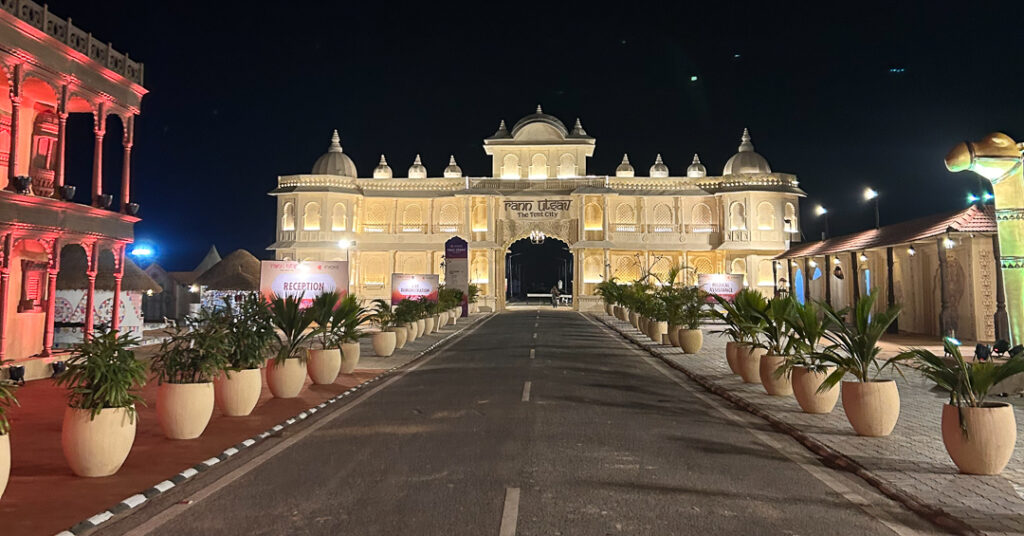Aashka Jadeja reveals the contents of the House of Amoda at Rann Utsav – Tent City, Dhordo village.
(A message to the reader.)
Dhordo village
Nestled amidst the vast white sands of the Great Rann of Kutch in Dhordo Village, Gujarat, India, boasts a rich tapestry of history and geography. Historically, it has served as a crucible of cultural amalgamation, reflecting the influences of diverse dynasties, from the ancient Indus Valley Civilization to the Mauryan and Gupta Empires. Its strategic positioning along ancient trade routes facilitated the convergence of varied cultures, imprinting an enduring legacy on its heritage.
Geographically, Dhordo lies at the heart of the Rann of Kutch, an expansive salt marsh that transforms into a captivating white desert during the dry season. Surrounded by vast salt flats and the distinctive topography of the Rann, the village is set amidst an ethereal landscape. The geographic isolation and challenging yet stunning environment have molded the resilience and resourcefulness of the local community.
In recent years, Dhordo has garnered attention as the host of the annual Rann Utsav, the largest white desert festival, a cultural extravaganza celebrating the region’s traditional arts, crafts, and folklore. This globally acclaimed event attracts tourists from far and wide, providing a platform to showcase the vibrant cultural heritage of Kutch.
The intertwining of Dhordo’s history and geography weaves a narrative that reflects the enduring spirit of a community deeply rooted in tradition while embracing modernity. Dhordo village is under the leadership of sarpanch Shri Miya Hussain Gul Beg. Today the land of Rann prospers and is celebrated every year with tourists visiting from all around the globe to witness the captivating beauty and ecosystem of Dhordo village.
Rann Utsav – Tent City
Rann Utsav: the tent city is a vibrant township, orchestrated by Evoke Experiences (owned by Mr Nikhil Agarwal, Mr Deepanshu Agarwal, Mr Upanshu Agarwal, and COO Mr Bhavik Sheth) and Gujarat Tourism. Spanning five lakh (500,000) square metres, it hosts 400 tents, welcoming over five lakh visitors annually for four months. Offering warm hospitality against the backdrop of the White Desert, the event celebrates Gujarat’s cultural diversity through arts, crafts, music, dance, and cuisine.
The Tent City blends luxury with tradition, providing an immersive experience with folk performances and adventure sports. It is a vibrant celebration of cultural tourism and hospitality, offering guests an unforgettable journey into Gujarat’s rich heritage. This magnificent and vibrant cultural festival received an accolade from UNWTO – Launched in 2021, the Best Tourism Villages initiative by UNWTO is part of its rural development program. Comprising three pillars – Best Tourism Villages, Upgrade Program, and Network –
The initiative aims to foster rural development, combat depopulation, and promote sustainability through tourism. Evaluating villages on nine criteria, including cultural preservation and sustainability, it recognizes those that nurture rural areas and preserving local heritage. In its third edition, 54 villages were selected from 260 applications. During the UNWTO General Assembly on 19th October 2023 in Samarkand Uzbekistan, “Dhordo village in India was honored as the Best Tourism Village, showcasing its exemplary contribution to rural tourism development through Rann Utsav – The Tent City.”
House of Amoda

In the heartland of Kutch, where the white salt desert meets vibrant tradition, House of Amoda unveils its second “Experience & Shop” series, “Weaving Tradition into Destination.” This initiative aims to create an awareness of Kutch’s traditional textiles while championing India’s heritage textile industry. This cultural lifestyle brand was founded in 1991 by Mrs Meeta Solanki Jadeja. It was later enriched by Mr Yuddhavir Singh Jadeja, a craft custodian and revivalist and a Creative Director since 2016, and Ms Aashka Jadeja, a Heritage professional (Intangible Cultural Heritage) expert in cultural business development & business branding since 2019. Embracing three sustainability principles – Culture, Livelihood, and Environment – House of Amoda’s philosophy, “we CRAFT our ART from HEART,” underscores its commitment to preserving traditional craft skills and knowledge.
Each piece is more than a product; it is a meticulously crafted work of art infused with human touch, passion, and emotion. House of Amoda serves not only as a curator of handcrafted fashion and textiles but also as a custodian of artistic expression, fostering a profound sense of cultural responsibility.
Contents of the Uuseum

Copper bells are a traditional craft practised by skilled metalworkers, often belonging to communities like the Kutchi Rabari and Ahir tribes. The process involves shaping and molding molten copper into intricate bell designs. The artisans employ various techniques such as casting, engraving, and detailing to create distinctive patterns on the bells each telling a unique story inspired by the cultural ethos of the region. Historically, these copper bells served a dual purpose. Beyond their aesthetic appeal, they were used in daily life and ceremonies. The sound of the bells was believed to have spiritual significance often used in rituals, celebrations and as part of traditional attire. The art of crafting copper bells in Kutch thus became deeply interwoven with the cultural and religious practices of the local communities. However, these handcrafted copper bells from Kutch are not only valued locally but also gained recognition globally for their unique craftsmanship and cultural resonance.
Ajrakh means ‘keep it today’ and is practised as a way of life by the Khatri community of Kutch and Sindh. Today the tenth generation practices the traditional skill of hand-blocking ajrakh printing and natural dyeing. The tradition of ajrakh printing is 4,000 years old. It involves a 16-step process and requires a high level of skill and concentration.
The art of Bhujodi weaving revolves around the small town of Bhujodi, located in Bhuj. This craft has been passed down through generations. Weavers belong to specific communities such as the Vankar community, known for their expertise in handloom weaving. Bhujodi textiles are characterized by intricate patterns, vibrant colors, and exceptional craftsmanship. The weavers employ a variety of traditional techniques including pit looms and hand-spun yarn, to create unique and high-quality textiles. The region’s harsh climate and the nomadic lifestyle of the locals have significantly influenced the choice of materials and designs resulting in durable and practical fabrics. Over the years, Bhujodi has evolved to incorporate contemporary elements while preserving its traditional essence.
Batik, an ancient wax-resist dyeing technique, found its way to Kutch through centuries of cultural exchange and trade along the Silk Road. The art form was embraced by the local communities, particularly the Kutchi Rabari and Ahir tribes, who transformed it into a distinctive craft reflecting their traditional aesthetic. Historically, batik in Kutch was closely associated with the daily lives of these communities, serving both functional and artistic purposes. The technique involves applying wax to fabric in specific patterns before dyeing it, creating intricate designs. The designs often draw inspiration from nature, mythology and everyday life making each piece a storytelling canvas.
- Clamp dye
- Bandani
Clamp dye or bandhani, is a traditional textile dyeing technique. The word “Bandhani” is derived from the Sanskrit word “bandh”, which means “to tie”. The process involves tying small portions of the fabric with thread to create intricate patterns, and then dyeing the fabric. The tied areas resist the dye, creating beautiful and vibrant patterns. This ancient art form is deeply rooted in the cultural heritage of Kutch. The craft requires great skill and precision, as artisans meticulously tie thousands of tiny knots to achieve the desired designs. The use of natural dyes adds to the uniqueness and authenticity of the craft.
Mashru is derived from the Arabic word for permitted or lawful, indicating the fabric’s compliance with Islamic principles. The fabric is known for its distinctive feature combining the luxuriousness of silk (wrap) with the durability of cotton (weft).
Kharad weaving has ancient roots and is believed to have been practised by pastoral communities of Kutch for centuries. The craft originated as a practical response to the harsh desert environment. The practice is deeply intertwined with the culture and lifestyle of communities to produce utilitarian needs with the help of locally available materials. The products include rugs, blankets, and other household textiles.
Rogan means “oil-based” derived from the Persian word. Its origin can be traced back to Iran. It was initially used to embellish to cover holy books. The art form travelled to India with the migration of the Khatri community from Sindh to Kutch in the early twentieth century.
The Namda toy craft practised in Kutch has its origins in the pastoral communities of the region. Traditionally, these communities raised sheep and the craft evolved as a sustainable way to utilize the wool produced by their herds. The craft has been passed down through generations, with artisans refining and adapting their techniques over time.
Through immersive installations and historical narratives, guests visiting the House of Amoda pavilion at Rann Utsav – Tent City are not just shoppers, they’re participants in a cultural odyssey.
Mindfully curated to evoke tactile sensations and admiration for craftsmanship, the experience aims to preserve Kutch’s languishing crafts. Each purchase or shared knowledge contributes to sustaining traditional art forms, fostering an awareness of the interdependency between rural tourism and textiles.
Rural tourism thrives on showcasing local cultures. Textiles serve as a vital cultural expression. This symbiotic relationship supports economic sustainability, preserving traditional craftsmanship and empowering local artisans. By promoting and valuing intangible cultural heritage, rural tourism becomes a platform for cultural exchange, enhancing the market value of locally crafted textiles while safeguarding cultural identity. This integration ensures economic benefits for rural communities while fostering sustainable development.
About Aashka Jadeja
 I belong to Ahmedabad (Gujarat), the first world heritage city of India. As a Heritage Professional I specialized in Intangible Cultural Heritage. At a tender age I had the opportunity to experience the textile (art & culture) sector of India, shaped by my family business, House of Amoda. This brand seeks to revive traditional textiles into meaningful contemporary “wearable heritage-art” apparel. Now at the age of 25, the learning from experiences has become a door of curiosity towards creating a vision in society to understand the ecosystem of the textile culture of India. As well as a deep interest in cultural business and creative-cultural economy to the unrecognised, unexplored yet soul-touching and a torch-bearer sector of the future.
I belong to Ahmedabad (Gujarat), the first world heritage city of India. As a Heritage Professional I specialized in Intangible Cultural Heritage. At a tender age I had the opportunity to experience the textile (art & culture) sector of India, shaped by my family business, House of Amoda. This brand seeks to revive traditional textiles into meaningful contemporary “wearable heritage-art” apparel. Now at the age of 25, the learning from experiences has become a door of curiosity towards creating a vision in society to understand the ecosystem of the textile culture of India. As well as a deep interest in cultural business and creative-cultural economy to the unrecognised, unexplored yet soul-touching and a torch-bearer sector of the future.











